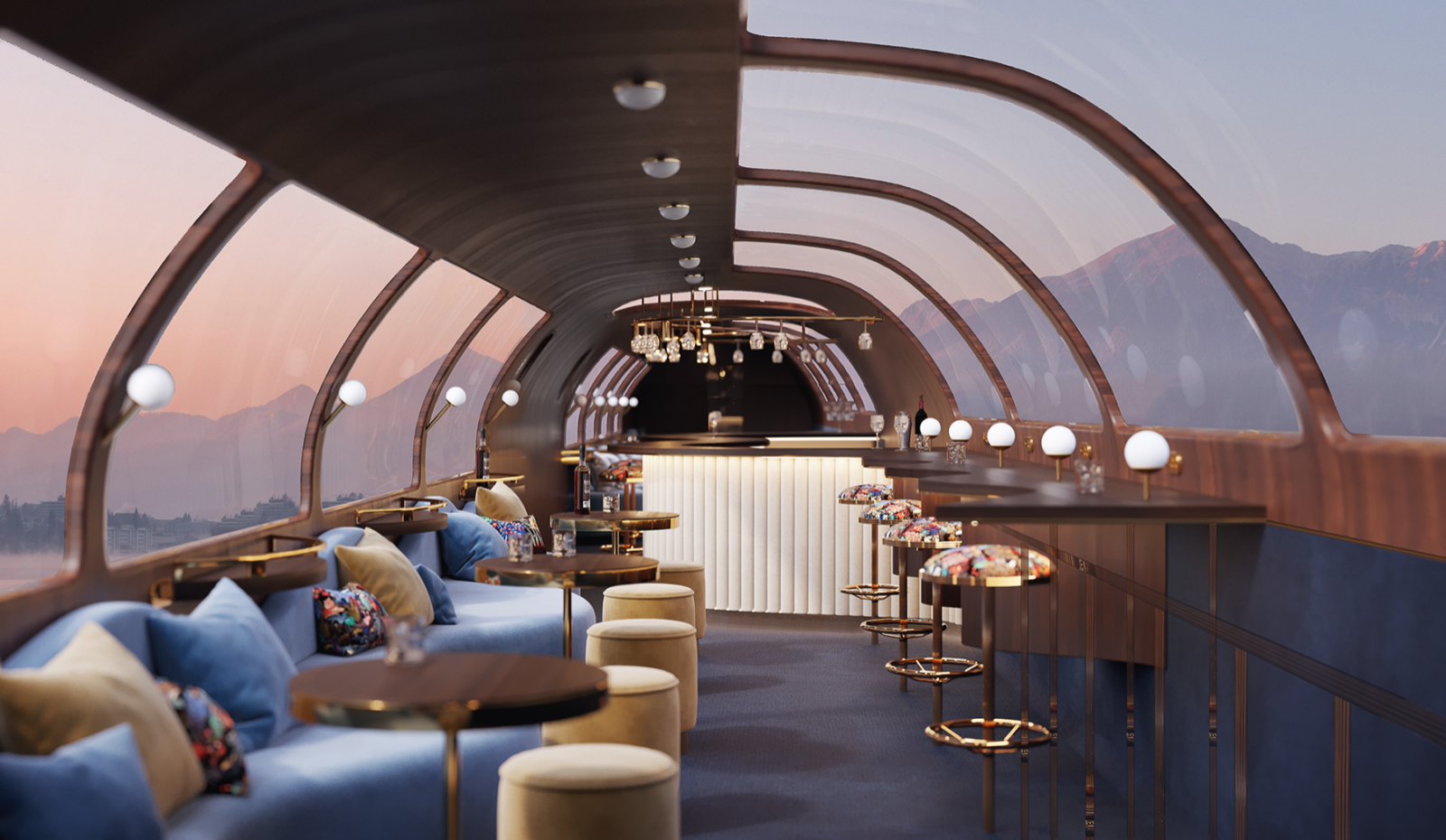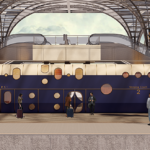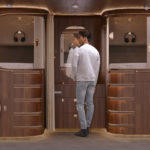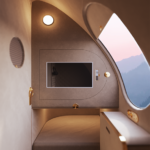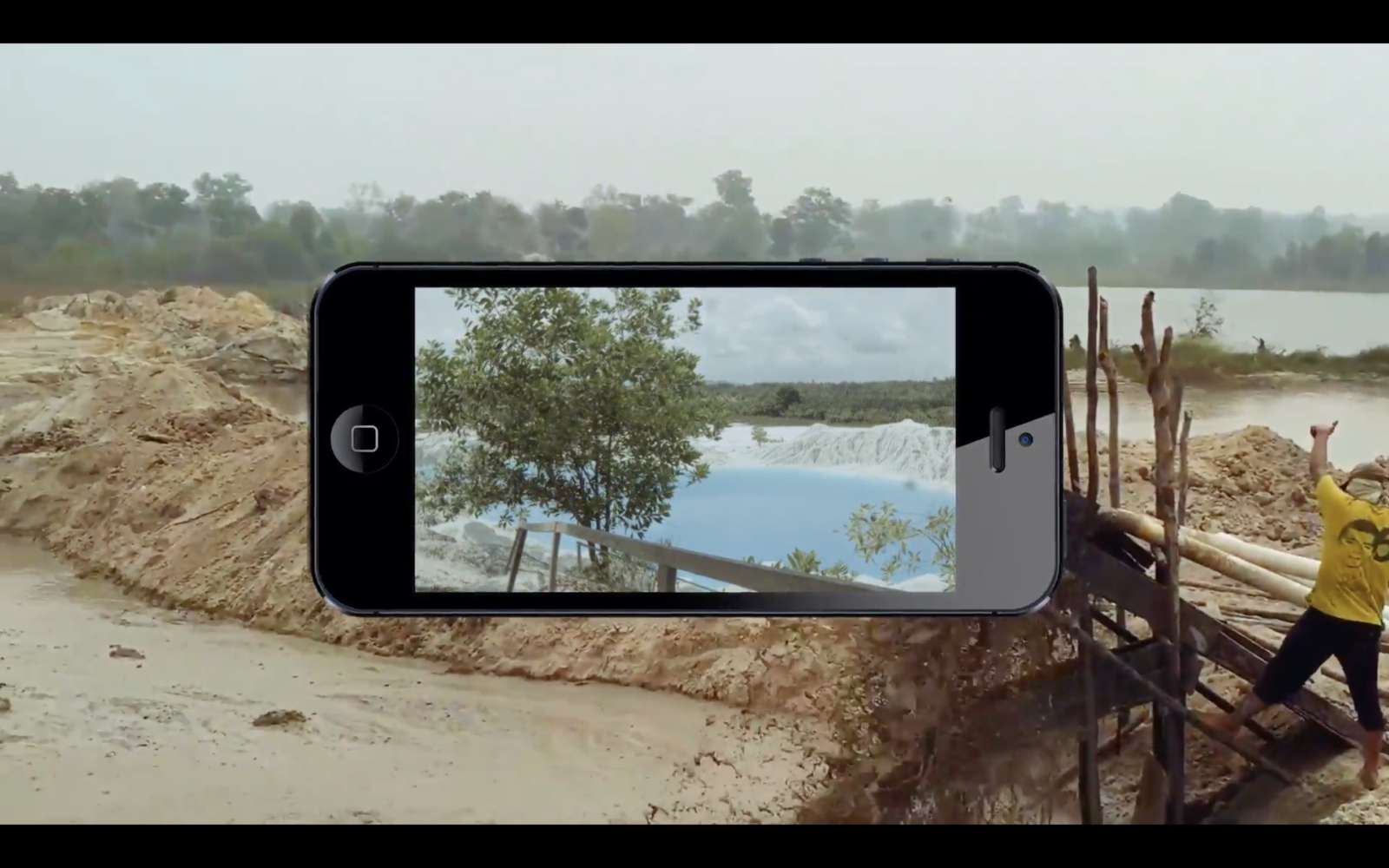Night express: when trains commute to comfort
Interview with interior architect Elizaveta Krikun
Abstract
Europe has set itself the goal of re-launching several night train lines in order to reduce the ecological footprint of passenger transport. There is talk of linking Paris to Barcelona or Madrid in one night by 2024. From Switzerland, the Basel-Amsterdam line has resumed night service. But these journeys are more reminiscent of plastic boxes than the elegance of the Orient Express. For her Master’s degree in Interior Architecture, Elizaveta Krikun examined this discrepancy between the image and reality of the night train. In her project, she drew inspiration from the trains of the Belle Epoque to design a contemporary and comfortable setting with high-quality materials, modular spaces, and communal areas for socialising.
Text
Julie Enckell Julliard: Can you tell me how your diploma project at HEAD started?
Elizaveta Krikun.: The general theme we were asked to work with was “the night”. At first I felt rather stuck, but then, one evening, looking at the passing trains from my window, I thought that a new concept of a night train could become an interesting Interior Architecture project. As it happens, I’ve always lived next to train stations and travelled a lot by train. It’s a means of transport I feel strongly connected to.
At the time I came up with the idea, I’d never been on a night train. I started wondering why they don’t seem so accessible to the public? Why, when you book a trip, does the night train not come up as one of the options? Why are they not so appealing to the public? When I started researching the subject, I realised that night trains have actually become quite popular recently due to the flight travel situation and the pandemic consequences, but the options available in Europe aren’t great.
J.E.J.: Did you travel by night train for your work on this project?
E.K.: Yes, of course. I took a SBB ÖBB train for a short trip, just to see it and take some pictures. I subscribed to several websites which offer virtual visits of different trains. I also talked with various professionals to make sure I wasn’t missing out on technical aspects. For a Master’s project you have certain freedom, but I wanted to be as accurate as possible, and to offer something that is realistic and feasible in real life.
J.E.J.: When you were on the train, what did you feel was missing there? What did you want to add?
E.K.: Everything was missing! As an interior architect, I’m especially interested in aesthetics and the question of comfort. I must say I wondered how it can be that in the 21st century people are still travelling in such poor conditions in terms of style and comfort. During the Belle Epoque era, the train was a luxurious and desired means of transportation. Then, following the devastation of WWII and with the rise of airlines and highways, the companies stopped investing so much in train development. It turned into a mass market concept where new materials like plastic came into being and the approach became very cost-effective. And later, the sleeper train sector stopped developing completely.
I wanted to create both small individual spaces offering privacy and larger ones where you could walk and socialise.
J.E.J.: In my mind, those early-century trains were meant for wealthy people only. Trains have indeed been quite ugly in recent years because they are designed for second-class travel now.
E.K.: Trains were considered a luxury but were not reserved for wealthy people only: travellers also had the option to book a cheaper ticket and share an open-section coach with many other passengers. On the other hand, richer people could book shared and private cabins; right up to an entire coach for themselves. In the end the ticket price varies, fundamentally, on the amount of space that you take.
For my project, I wanted to create both small individual spaces offering privacy and larger ones where you could walk and socialise – as I’ve often heard that some people enjoyed the fact of making new friends on a night train, while others would complain on having to share a cabin with strangers. The idea was to therefore dedicate some coaches to spacious public zones with activities like bars, gym, salon, shop etc. all the while developing cosy and rather compact sleeping coaches with private capsules and semi-private dressing zones. I believe that we only need a certain amount of space to sleep comfortably, not an entire cabin, especially if it’s a shared one.
J.E.J.: Listening to you I’m thinking of the experience you get while travelling by planes nowadays. With low-cost companies, you really don’t feel comfortable, your body suffers and you just don’t feel well-treated. You get tired, eat badly and the light is awful. You don’t pay much but you don’t feel relaxed when you arrive at your final destination, which is paradoxical because you don’t go on a holiday to feel even more tired. Is your project part of a broader consideration on how we travel?
E.K.: Yes of course. It is also meant to remind people that there are other ways to travel, outside the low-cost airline companies. It is certainly more eco-friendly than flying, which is highly important nowadays.
If we only talk about low-cost flights, then most probably my final train design proposal would face some difficulties if trying to compete with them in terms of price and the travel time, but it could offer so much more on the other hand, and that’s what I proved with my work. Overall, this project is a call for people to slow down and rewind. Real changes take time.
To make the passenger feel special.
J.E.J.: What was the most important experience you wanted to introduce in this night train?
E.K.: For me the idea is to make the trip an unforgettable experience and to make it relevant to contemporary life. The most important aspect would be the comfort, the style. For people to feel they are the stars of a Belle Epoque movie. To make the passenger feel special.
However, it is very important to mention that my project is a concept of a night train, and not a finalised product that I developed for any existing company. I spent a lot of time developing the way it works, what it provides, its very particular layout etc. The final look of the interiors is only my personal designer’s vision that I had to propose in order to make it a complete project. On the other hand, I know that the concept that I developed can be easily implemented with other materials and details, creating an even more affordable version while keeping all the comfort and services.
I hope this project will inspire others and possibly influence the night trains of the future.
J.E.J.: Are there prospects that this will happen, or do you have any wishes in that regard?
E.K.: I’d be happy to participate in some architecture competitions to present the project and I’d be very interested in collaborating with a company. More generally, I’m willing to explore the broad practice of Interior Architecture in all its aspects, also creating alternative spaces. But I did study the subject of trains very thoroughly and I’ve become a bit of an expert. I think there are no questions on the topic related to my project that I wouldn’t be able to answer.
Elizaveta Krikun’s Night Express in pictures
